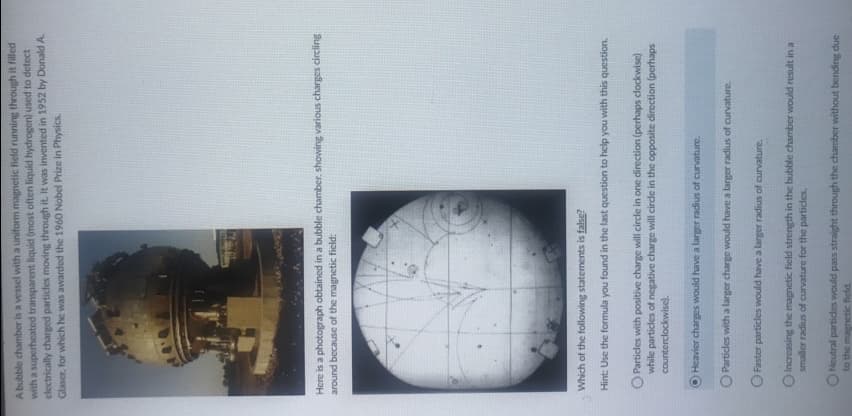A bubble chamber is a vessel with a uniform magnetic field running through it filled with a superheated transparent liquid (most often liquid hydrogen) used to detect electrically charged particles moving through it. It was invented in 1952 by Donald A. Glaser, for which he was awarded the 1960 Nobel Prize in Physics. Here is a photograph obtained in a bubble chamber, showing various charges circling around because of the magnetic field: Which of the following statements is false? Hint: Use the formula you found in the last question to help you with this question. Particles with positive charge will circle in one direction (perhaps clockwise) while particles of negative charge will circle in the opposite direction (perhaps counterclockwise). Heavier charges would have a larger radius of curvature. O Particles with a larger charge would have a larger radius of curvature. O Faster particles would have a larger radius of curvature. O Increasing the magnetic field strength in the bubble chamber would result in a smaller radius of curvature for the particles. O Neutral particles would pass straight through the chamber without bending due
A bubble chamber is a vessel with a uniform magnetic field running through it filled with a superheated transparent liquid (most often liquid hydrogen) used to detect electrically charged particles moving through it. It was invented in 1952 by Donald A. Glaser, for which he was awarded the 1960 Nobel Prize in Physics. Here is a photograph obtained in a bubble chamber, showing various charges circling around because of the magnetic field: Which of the following statements is false? Hint: Use the formula you found in the last question to help you with this question. Particles with positive charge will circle in one direction (perhaps clockwise) while particles of negative charge will circle in the opposite direction (perhaps counterclockwise). Heavier charges would have a larger radius of curvature. O Particles with a larger charge would have a larger radius of curvature. O Faster particles would have a larger radius of curvature. O Increasing the magnetic field strength in the bubble chamber would result in a smaller radius of curvature for the particles. O Neutral particles would pass straight through the chamber without bending due
Principles of Physics: A Calculus-Based Text
5th Edition
ISBN:9781133104261
Author:Raymond A. Serway, John W. Jewett
Publisher:Raymond A. Serway, John W. Jewett
Chapter22: Magnetic Forces And Magnetic Fields
Section: Chapter Questions
Problem 51P
Related questions
Question
Please help is number three for this question correct. Why or why not

Transcribed Image Text:A bubble chamber is a vessel with a uniform magnetic field running through it filled
with a superheated transparent liquid (most often liquid hydrogen) used to detect
electrically charged particles moving through it. It was invented in 1952 by Donald A.
Glaser, for which he was awarded the 1960 Nobel Prize in Physics.
Here is a photograph obtained in a bubble chamber, showing various charges circling
around because of the magnetic field:
Which of the following statements is false?
Hint: Use the formula you found in the last question to help you with this question.
O Particles with positive charge will circle in one direction (perhaps clockwise)
while particles of negative charge will circle in the opposite direction (perhaps
counterclockwise).
O Heavier charges would have a larger radius of curvature.
O Particles with a larger charge would have a larger radius of curvature.
O Faster particles would have a larger radius of curvature.
O Increasing the magnetic field strength in the bubble chamber would result in a
smaller radius of curvature for the particles.
O Neutral particles would pass straight through the chamber without bending due
to the magnetic field.
Expert Solution
This question has been solved!
Explore an expertly crafted, step-by-step solution for a thorough understanding of key concepts.
Step by step
Solved in 2 steps

Knowledge Booster
Learn more about
Need a deep-dive on the concept behind this application? Look no further. Learn more about this topic, physics and related others by exploring similar questions and additional content below.Recommended textbooks for you

Principles of Physics: A Calculus-Based Text
Physics
ISBN:
9781133104261
Author:
Raymond A. Serway, John W. Jewett
Publisher:
Cengage Learning

Physics for Scientists and Engineers with Modern …
Physics
ISBN:
9781337553292
Author:
Raymond A. Serway, John W. Jewett
Publisher:
Cengage Learning

Physics for Scientists and Engineers, Technology …
Physics
ISBN:
9781305116399
Author:
Raymond A. Serway, John W. Jewett
Publisher:
Cengage Learning

Principles of Physics: A Calculus-Based Text
Physics
ISBN:
9781133104261
Author:
Raymond A. Serway, John W. Jewett
Publisher:
Cengage Learning

Physics for Scientists and Engineers with Modern …
Physics
ISBN:
9781337553292
Author:
Raymond A. Serway, John W. Jewett
Publisher:
Cengage Learning

Physics for Scientists and Engineers, Technology …
Physics
ISBN:
9781305116399
Author:
Raymond A. Serway, John W. Jewett
Publisher:
Cengage Learning


Physics for Scientists and Engineers
Physics
ISBN:
9781337553278
Author:
Raymond A. Serway, John W. Jewett
Publisher:
Cengage Learning

Glencoe Physics: Principles and Problems, Student…
Physics
ISBN:
9780078807213
Author:
Paul W. Zitzewitz
Publisher:
Glencoe/McGraw-Hill